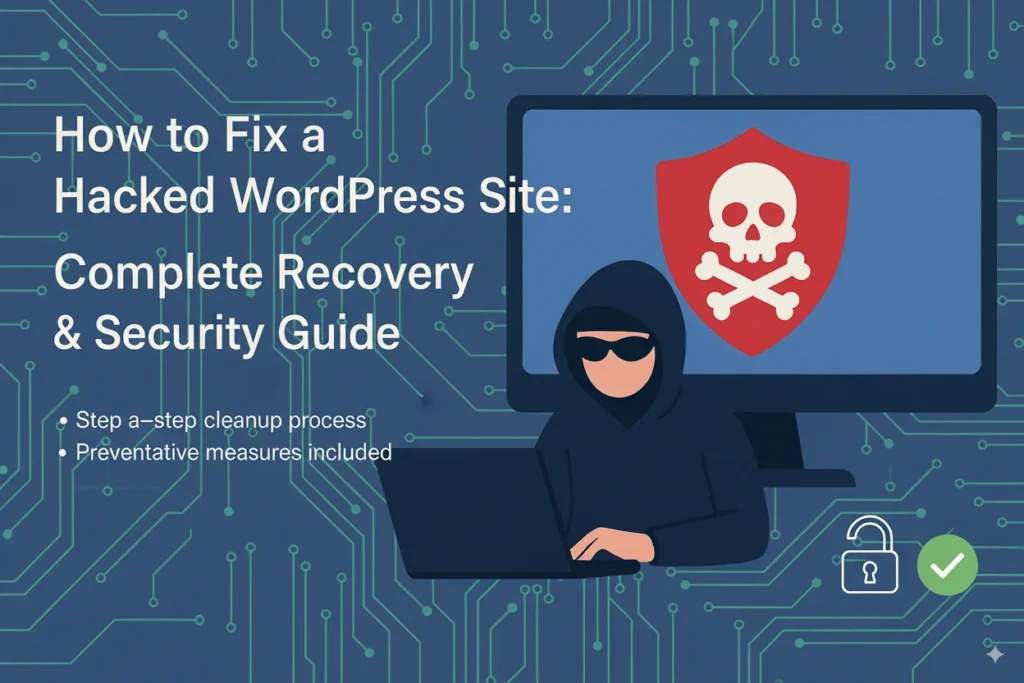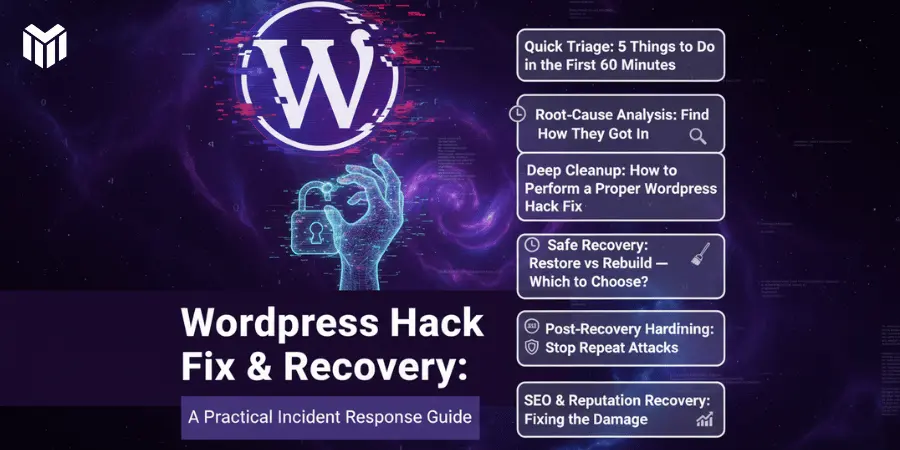Getting your WordPress website hacked isn’t just a big-business problem—it can happen to anyone. In fact, most attacks are automated bots scanning the internet for outdated plugins, weak passwords, or unmaintained sites. That means freelancers, bloggers, eCommerce owners, and small business websites are often the easiest targets.
So, what should you do if your WordPress site has been hacked?
This step-by-step guide will show you how to identify a WordPress hack, remove malware, restore your website safely, and secure it from future attacks. You’ll also see how a professional WordPress security service like WP SitePlan can help you recover faster and protect your investment.
How to Know If Your WordPress Site Has Been Hacked
Many site owners don’t notice a hack until Google blacklists their site or customers complain. Watch for these red flags:
- Redirects to spammy or adult sites
- Strange pop-ups or unwanted ads
- Hidden backlinks or injected content
- New admin users you didn’t create
- Site running unusually slow or crashing
- Security warnings from browsers or Google
If you notice any of these symptoms, your website may already be compromised.
First Steps: What to Do Immediately After a WordPress Hack
When it comes to WordPress malware removal, speed is critical. The faster you act, the less damage hackers can cause.
1. Put Your Site in Maintenance Mode
Prevent visitors and search engines from accessing infected pages. This helps protect your reputation and SEO while you clean up.
2. Change All Passwords
Update your WordPress admin, hosting, FTP/SFTP, and database passwords. Delete any suspicious or unauthorized users.
3. Back Up the Infected Site
Before making changes, take a full backup. This snapshot will help security experts analyze the breach and restore files if needed.
4. Scan for Malware
Use a trusted WordPress malware scanner (like Wordfence or Sucuri) to detect:
- Malicious PHP files in
/wp-content/ - Script injections in theme headers/footers
- Fake plugins or themes
- Hidden backdoor files
Cleaning Up: How to Fix a Hacked WordPress Site
Here’s where most site owners struggle. A quick DIY cleanup might remove visible malware but leave behind hidden code that allows hackers back in.
Option 1: Manual Cleanup (DIY)
- Replace core WordPress files with fresh copies from WordPress.org
- Reinstall all plugins and themes from trusted sources
- Delete suspicious code or files in your database and uploads folder
- Reset WordPress security keys in
wp-config.php
⚠️ Warning: Manual cleanup is risky—miss one infected file and hackers can reinfect your site in hours.
Option 2: Professional WordPress Malware Removal (Recommended)
Services like WP SitePlan’s Advanced Security handle the process for you:
- Full manual malware removal
- Backdoor detection and elimination
- Closing WordPress vulnerabilities
- Safe website restoration
- Ongoing protection against future hacks
Why Hosting Alone Won’t Protect You
Many site owners assume their WordPress hosting provider will fix security breaches. Unfortunately, most hosting companies only:
- Quarantine infected files (they don’t clean them)
- Don’t patch plugin or theme vulnerabilities
- Don’t monitor for future attacks
That’s why relying only on hosting support is not enough—you need dedicated WordPress security management.
Is Restoring a Backup Enough?
Restoring a backup may seem like a quick fix, but it doesn’t solve the root problem. If your backup is infected or your site vulnerabilities remain, hackers will return.
To do it safely:
- Scan the backup before restoring
- Patch vulnerabilities first
- Only use a verified clean backup
WP SitePlan clients get daily off-site backups, making recovery faster and safer with minimal downtime.
How to Protect Your WordPress Site from Future Hacks
Prevention is always better (and cheaper) than cure. Here are must-do WordPress security best practices:
✅ Keep WordPress, plugins, and themes updated
Outdated software is the #1 cause of WordPress hacks. WP SitePlan handles all updates automatically.
✅ Audit plugins and themes regularly
Remove abandoned, nulled, or untrusted plugins that put your site at risk.
✅ Use strong passwords + 2FA
Protect admin accounts with complex passwords and enable two-factor authentication.
✅ Install a WordPress firewall
Tools like Wordfence and Sucuri block attacks before they reach your site.
✅ Enable real-time monitoring
With WP SitePlan, you get 24/7 monitoring, malware scans, and proactive security support.
Don’t Let a Hack Destroy Your SEO Rankings
A hacked WordPress site doesn’t just damage your reputation—it kills your SEO. Google blacklists hacked sites, causing:
- Dropped rankings
- Lost organic traffic
- Lower trust from customers
To recover:
- Clean your site completely
- Request Google review in Search Console
- Monitor site performance after cleanup
What WP SitePlan Offers
WP SitePlan is more than just malware removal—it’s complete WordPress security management:
- Emergency hacked site recovery
- Manual malware and backdoor removal
- Secure restoration and cleanup
- Daily backups and audits
- Ongoing monitoring & performance alerts
- Affordable WordPress security plans for all users
Whether you’re a solopreneur, small business, or agency, WP SitePlan protects your site so you can focus on running your business.
FAQs: Fixing a Hacked WordPress Site
How do I know if my WordPress site is hacked?
Look for redirects, spam content, strange users, or sudden slowdowns. A scan can confirm.
Can WP SitePlan clean my hacked site?
Yes. They remove malware, secure your files, and restore your site safely.
Will a hack hurt my SEO?
Yes. But fast, professional cleanup can limit long-term SEO damage.
Is WordPress security worth paying for?
Absolutely. The cost of recovery, lost traffic, and lost revenue is much higher than ongoing protection.
Final Thoughts
Fixing a hacked WordPress site isn’t just about removing malware—it’s about securing your site permanently. DIY fixes often fail, leaving your website open to reinfection.
With WP SitePlan, you get expert WordPress malware removal, continuous monitoring, and proactive protection.
👉 Don’t just clean your hacked site—secure it for good.




1 comment
Salar
Informative